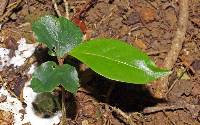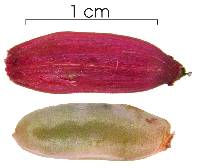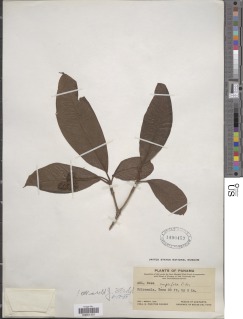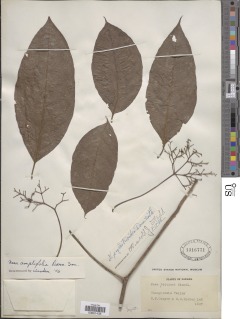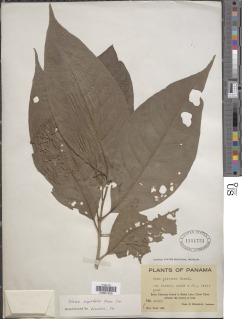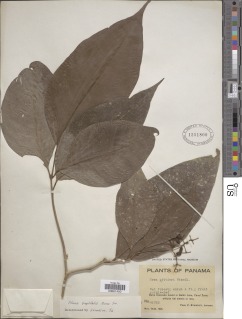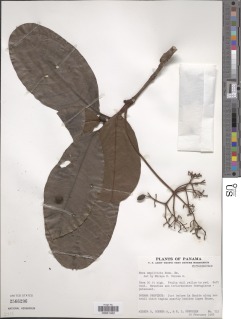

|
|
|
|
Family: Nyctaginaceae
canelito, more...Canelo
|
Descripción: Árbol o arbusto de 1 a 5 m de alto. Tronco ramificado a baja altura. Ramitas terminales cubiertas de pelos rojizos. Hojas simples, opuestas o verticiladas, de 15-30 x 5-11 cm, oblanceoladas o elípticas, con ápice largamente acuminado, bordes enteros y base decurrente. Las hojas son membranosas y quebradizas, presentan pelos rojizos sobre las nervaduras del envés. Pecíolo de 1-5 cm de largo. Flores rosadas. Frutos elipsoidales, de 1-1.5 cm de largo, verdes, torrándose rojos al madurar. Datos Ecológicos: La especie crece a bajas y medianas elevaciones en bosques húmedos o muy húmedos. En Panamá se encuentra en las provincias de Bocas del Toro, Chiriquí, Coclé, Colón, Darién, Panamá, Veraguas y la comarca de Guna Yala. Común en los márgenes de áreas boscosas de la vertiente del Caribe en Panamá. Florece y fructifica durante todo el año, principalmente de julio a octubre. Especies Parecidas: A menudo se confunde con plantas del género Psychotria, pero Psychotria presenta estípulas y Neea no tiene estípulas. Cuando N. amplifolia presenta hojas verticiladas se confunde con LK hamepa Hamelia patens LK2 , pero H. patens tiene estípulas. Usos: La especie no tiene usos conocidos. N. pittieri Standl. Dioecious shrub, usually less than 2 m tall (to 7 m); younger branches densely ferruginous-pubescent, becoming glabrate in age. Leaves opposite or nearly so; petioles 0.5-5 cm long, canaliculate, often somewhat reddish; blades +/- elliptic, ovate to obovate-elliptic, abruptly to gradually long-acuminate, obtuse to attenuate at base, 7-36 cm long, 3-15 cm wide, entire, glabrous above, glabrate to puberulent below. Inflorescences terminal, obscurely dichasial thyrses, essentially glabrous to densely ferruginous-pubescent, 4-15 cm long, bearing few to many flowers; staminate flowers narrowly tubular-urceolate, 5-10 mm long, about 2.5 mm wide, the perianth with 5 short lobes, the limb weakly spreading; stamens 8, to 5.5 mm long, included, attached near base of tube; filaments of different lengths, united into a short tube around the sessile pistillode. Pistillate flowers similar to staminate flowers but with a prominent constriction about one-third of the way down the perianth tube, thickened within at point of constriction; style and staminodia (usually 9) fitting tightly through the constriction, included, later exposed when the upper third of perianth above the constriction withers and falls; staminodia held just above constriction; ovary narrowly elliptic, sessile, at first loosely enveloped by perianth, by maturity completely filling it; style slender; stigma with few divisions. Anthocarp elliptic-oblong, ca 1 cm long, at first reddish, becoming violet-purple at maturity, the persistent perianth fleshy and sweet; seed solitary, somewhat shorter than fruit. Croat 4213, 5626. Frequent in the forest. Flowers throughout the year, most commonly from March to September. The fruits are most common from June to December. Standley (1933) also reported N. psychotrioides Donn. Sm., which is a Costa Rican species earlier confused with N. laetevirens Standl. of the Atlantic slope of Panama. N. laetevirens probably does not occur on BCI. Most of the material from BCI assigned the name N. psychotrioides isN. amplifolia. A single sterile collection, Shattuck 121, is in doubt; it does not appear to be typical of N. amplifolia. However, it can be stated with confidence that a second species of Neea does not now occur on the island. Leaves of the species are consistently host to various cryptogamic epiphytes, including mosses and lichens. Costa Rica and Panama. In Panama, known principally from tropical moist forest in the Canal Zone, all along the Atlantic slope, and in Darien; known also from premontane wet forest in Colón Chiriqui, and Coclé and from tropical wet forest in Colón. Bocas Species Database Characteristics: Tree, Shrub |
|
|
|





